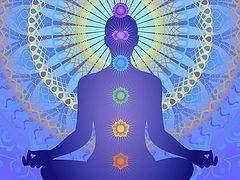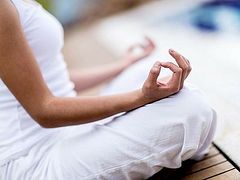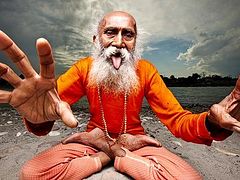 A monument to A. Ghose Nowadays yoga classes are offered in any fitness center. How did this happen? Yoga used to be practiced by Hindus only. The situation changed approximately 150 years ago. British culture was persistently promoted in India. Some locals were eager to absorb the new culture, while others ignored it. Some tried to convince the British that Indians had their indigenous culture, and Hinduism was not merely one of the national religions but a strict adherence to the eternal and universal order of life. According to them, the eternal order (Sanatana Dharma) is applicable to the best followers of any religion, almost like laws of physics are applicable to all people. The Indians used yoga as an example to demonstrate the validity of such statements to Christians.
A monument to A. Ghose Nowadays yoga classes are offered in any fitness center. How did this happen? Yoga used to be practiced by Hindus only. The situation changed approximately 150 years ago. British culture was persistently promoted in India. Some locals were eager to absorb the new culture, while others ignored it. Some tried to convince the British that Indians had their indigenous culture, and Hinduism was not merely one of the national religions but a strict adherence to the eternal and universal order of life. According to them, the eternal order (Sanatana Dharma) is applicable to the best followers of any religion, almost like laws of physics are applicable to all people. The Indians used yoga as an example to demonstrate the validity of such statements to Christians.
Indian intellectuals Europeanized yoga, and yoga exercises began to be perceived as scientific experiments and centuries-proven techniques that could help people overcome various life challenges and resolve medical, psychological, and spiritual problems. One hundred years ago, yoga became a fashionable and popular trend.
One hundred years ago, yoga became a fashionable and popular trend.
Nowadays many people believe that hatha yoga is primarily a healthy workout. It is not. Let us look it up in the yoga monography published in India:
“Hatha yoga... is a branch of the Hindu soteriology; that is, a system of techniques developed to help those who practice it achieve relief and salvation”1
Soteriological techniques! So, people practicing hatha yoga strike uncomfortable poses and do breathing exercises not for the sake of health, but for the sake of salvation. A Christian theological term—soteriology—was openly used to define yoga.
Yes, yoga is an ascesis (sadhana), and yogic teachings are based on soteriology. Yoga exercises are spiritual practices representing the neo-Hinduist way of attaining salvation.
Comparing yoga to Christian ascesis—Making a choice
 M. Alfassa and a yogi. It is important to decide what we are going to compare, for selection of proper comparison items is the key to obtaining meaningful results. The Orthodox tradition of Hesychasm seems to be a more fitting example of the Christian ascesis than British Protestantism because Anglicanism incorporates only fragments of the traditional Christian ascesis and is tainted by some arbitrary ascetic techniques and external influences.2
M. Alfassa and a yogi. It is important to decide what we are going to compare, for selection of proper comparison items is the key to obtaining meaningful results. The Orthodox tradition of Hesychasm seems to be a more fitting example of the Christian ascesis than British Protestantism because Anglicanism incorporates only fragments of the traditional Christian ascesis and is tainted by some arbitrary ascetic techniques and external influences.2
Integral Yoga is a good example of yogic ascesis, since it was developed by Aurobindo Ghose (Sri Aurobindo, 1872-1950) on the basis of the classic yoga schools. Ghose graduated from a university in England, which allowed him to practice yoga and methodically analyze the meaning of the yoga exercises. Ghose has dozens of thousands of followers all over the world. There are even large Integral Yoga Centers in St. Petersburg and Moscow.
Yoga is perceived as a chance for people to further evolve
In essence, Integral Yoga has three components:
-
Ascesis based on the classical yoga schools;
-
Personal occult experiences of A. Ghose and his associate Mirra Alfassa (aka The Mother, 1878-1973);
-
An original take on evolutionary theory—yoga is perceived as a for people to evolve further. The goal of Integral Yoga is to ensure the evolution of people’s minds into superminds (supramentalization); those practicing Integral Yoga will supposedly achieve immortality.
Phases of ascesis: Two pictures in broad strokes
The Ladder of Divine Ascent describes Hesychastic ascesis as thirty steps that Christians need to take to achieve ascension. Such ascension is impossible without help from above, without Divine grace descending upon people. The first ascetic steps of The Ladder of Divine Ascent primarily focus on exercise in repentance (Steps 1-7). They are followed by the steps aimed at struggle with the passions (Steps 8-26). Holy stillness is a rarely achieved experience of holy living (Hesychasm, Step 27). Then comes the step of sacred prayer (Step 28), and finally the step of dispassion (Step 29) and the step of Divine love (theosis, Step 30).
A. Ghose believed that Krishna resided in his body and that his body would never die. Nevertheless, Ghose passed away in 1950.
Integral Yoga’s approach to asceticism differs from Christian spiritual ascension. Along with ascension/evolution (from matter to spirit), Integral Yoga also comprises descension/devolution (from spirit to matter). In other words, Integral Yoga describes bidirectional spiraling in hemisphere.
The first phase of Integral Yoga is achieving the silent mind. This experience creates favorable conditions for the next essential phase—receiving the descending “force of Sri Aurobindo and the Mother.” In this phase, Integral Yoga allegedly surpasses the supramental states of mind achievable in classic yoga3 and yogis believe that those who reach this stage are on a par with gods.
If yogis continue with these ascetic practices, they become superior to the Hindu gods and gods of other religions. When they reach the phase of so-called yoga of the cells, further supramentalization of their mind and body occurs on the cellular level. A. Ghose believed that Krishna resided in his body and that his body would never die. Nevertheless, Ghose passed away in 1950.
The phase of silence—Details and comparison
The concept of the silent mind in Integral Yoga means stopping the flow of thoughts and observations. A. Ghose used to say that “a bowl must be emptied so that the divine drink can fill it.” Yogis clear their minds off “vibrations/thoughts” to shift from mental consciousness to higher levels. Silence supposedly gives yogis the ability to discern vibrations; for example they can differentiate between the vibration of anger and the vibration of spiritual revelation.
Silence is occasionally accompanied by a sleep-like trance. Ghose disapproved of the yogis who overindulged in “the sleep” considering it the highest stage. A yogi can achieve silence using psychological techniques. To achieve this phase, yogis need to practice systematically. Their routine includes such exercises as clearing their minds for several minutes, repeating the same mantra that led them to yoga, imagining themselves on a quiet surface of the ocean and merging with its endlessness.
Unlike Integral yoga, Christian ascesis does not begin with silence. First, repentance is needed cleanse oneself of sinful impurities. The Greek Church fathers understood repentance to be the changing of the mind, but this is by no means the same as the altered state of mind achieved in yoga. Repentant metanoia makes Christians realize that the sins they carelessly committed earlier keep them away from the eternal blessedness of the Heavenly Kingdom.
Let us compare. A. Ghose believed that Christ’s commandment to seek first the Kingdom of God was a call to equate oneself with a deity through yogic meditations. Such interpretation of the Heavenly Kingdom is unacceptable for Orthodox Christians. We do not consider ourselves equal to God; we are but His creations. Our sins drive us away from God, while our repentance brings us closer to Him.
The required preparation for holy stillness, including repentance and overcoming sinful passions, is foreign to yoga. Integral Yoga does not deal with the problem of sinful passions; instead it focuses on self-control and repression of the ideas and desires that control a person’s mind (this includes anger management). Yoga uses psychological techniques to resolve this problem. There is a crucial difference between the concept of the silent mind in Integral Yoga and the Hesychastic stillness of the mind, as the latter is used to free the mind from sinful thoughts. The similarity between the concepts of thought and vibration does not make the ascesis of Hesychasm and yoga closer to each other.
Descending “Force of Sri Aurobindo”. Details and comparison
Asanas of hatha yoga and exercises of raja yoga awaken the “force of kundalini”. This force flows upwards in a person’s “subtle body” through “chakras”. These energy centers are inactive in a regular person and yoga activates them. This is the true goal of yoga; it is not health or relaxation!
Integral Yoga offers an alternative for the “force of kundalini”. The more powerful “force of Aurobindo” is a descending, and therefore, “more divine” force. It was A. Ghose who made this superpower available to his disciples. He used to boast that Integral Yoga begins where most yogis finish their training. According to him, hatha yoga helps achieve “silence” and awaken kundalini, but it does not provide the descending superpower/consciousness. In Integral Yoga, the super force descends upon a person’s head and then moves down to the heart and lower.
After receiving the “force/consciousness of Sri Aurobindo”, you are enlightened—a “Witness” is now dwelling in your conscience. You no longer need to ponder problems and look for information in books. All you have to do is tap into the “force of Aurobindo” to access knowledge/gnosis, and the “Witness” will guide you in the right direction. “The force of Sri Aurobindo and the Mother” helps people practice yoga continuously and effortlessly.
Let us compare this concept to the Hesychastic experience of bringing the mind into the heart. At a cursory glance, it seems similar to the descending force in Integral Yoga. Yogis may receive the descending force during japa, i.e. multiple repetition of a sacral formula. Based on this, G. van Vrekhem in his book on Integral Yoga concluded that yoga exercises were similar to the Jesus’ Prayer of the heart. However, he was more inclined to find the similarities between yoga and ancient heretical gnosis characterized by pantheism, reincarnation and occultism. A. Ghose himself said that his ascesis was neo-gnostic in nature:
“In the moment of gnostic transformation, evolution crosses a line beyond which occurs a supreme and radical reversal of consciousness… it is difficult for mental thought to understand… supramental nature.”
A. Ghose planned to become a gnostic superman.
The term “gnosis” also exists in the Hesychastic tradition, but it has a different meaning and is used in a different context. Repentant struggle against passions leads Christians to holy stillness and knowledge/gnosis. What kind of knowledge do hesychasts obtain? They learn the logoi of the created world; that is they learn God’s plans for the created world. Integral Yoga offers a totally different knowledge of the world: An impersonal deity itself becomes a cosmos. In other words, the deity is devolved, while a person’s evolution consists in gaining knowledge of the divine nature of people and the divinity of the entire cosmos.
The goal of classic yogic practices is to alter the mind, while the Hesychastic practices strive to achieve personal communication with God.
M. Eliade, a religion scholar who practiced yoga, also made a distinction between the spirituality of neo-Hinduism and Christianity. Speaking about the Jesus Prayer, Eliade noted that the goal of the classic yogic practices (pranayama) is to alter the mind, while through the Hesychastic practices [Christians] strive to achieve personal communication with God.
Hesychasts identify two steps of the sacred prayer to God: a stage of heartfelt prayer and a stage of continuous/self-initiating prayer. Again, it seems similar to Integral Yoga, but the similarity is only skin-deep, as on a certain stage of the ascesis, the descending force turns into a continual rather than short-term experience. “The force of Sri Aurobindo” reaches the heart and then moves down. In contrast, as St. Ignatius (Brianchaninov) wrote, focusing ascetic practices below the heart is the cause of false religious experiences.
Yoga of the cells—details and comparison
After ridding oneself of vibrations, a yogi’s mind becomes “silent” and is filled with “the divine drink” by way of “the force of Aurobindo”. B. Enginger,4 the closest disciple of “the Mother”, described this phase of Integral Yoga as follows.
“The first “drops” are simply exhiliarating… the cells are filled with delight – just like cherries in brandy… no “ecstasies” can be compared to that corporeal wonder”
A few weeks later, B. Enginger’s permeation with the supramental was replaced with the more powerful impact of the descending force. A mystical hammer seemed to be pounding on his body. It was a painful—“martyric”—transformation, and Enginger felt that the cells of his body were “crying”, repeating the mystical mantra, “You ARE Here.”
Enginger mistakenly believed that yoga of the cells would give him immortality. A. Ghose explained the process of achieving immortality as follows: The chakras would take over the functions of the bodily organs and the person would have the undying “body of light”. Ghose believed that “the divine creature leading a gnostic life would have a profound and clear understanding of what was happening in others, and perceive their consciousness and lives as his/her own... and that the actions of such creature would not be based on the superficial love.5
Instead of immortality, Enginger experienced nothing more than religious ecstasies with occult intoxication. He perceived the light of the surrounding objects, walked inside objects, and enjoyed super-effective relaxation provided by the light. He also experienced the ecstasies of contact with Agni, the god of fire.
Now let us compare the yogic experience with the highest Christian ascesis—dispassion, i.e., “the resurrection of the soul before the resurrection of body”. Overcoming spiritual death (sins and passions) puts a man on the threshold of the created world, ensuring theosis and preceding the eschatological resurrection of the dead. According to St. Silouan the Athonite, dispassion transforms a Hesychast’s body into relics, bestowing grace upon the hesychast just as grace is bestowed upon martyrs. We know from the history of the Church that martyrs could endure inhuman tortures. It was not because they were in a religious trance that had an anesthetic effect. There was a different reason. The martyrs’ bodies were transformed by grace, and just like sacred relics they were higher than their suffering, at times higher even than physical corruption.
Elder Silouan’s dispassion was like communion of Divine, fiery love (The Ladder of Divine Ascent, Step 30). He saw the Divine Light. This was not a hallucinatory trance, but a personal communication with our beloved Lord Jesus Christ, a supernatural, visual, and mental perception of Christ. Fr. Silouan’s dispassionate love manifested itself in the form of love toward his enemies. This act of love was difficult for the elder, as the enemies of the Church were torturing and executing Christians in his homeland.
Elder Silouan aspired to foster love, avoiding the soul-crushing feeling of hatred for one’s persecutors. In contrast to Enginger, he did not want his life to be a pursuit of enjoyable trances or religious intoxication. Fr. Silouan did not search for illusory unity with the surrounding world on the other side of the “superficial love” described by Ghose. Real love for God and people is a profound feeling. This love will start burning in your heart if you reject the self-deification that inherent to yoga. Love is fostered by the Divine grace. Instead of learning to control desires and getting rid of vibrations, it requires people to overcome anger, pride and other passions.
Things I did not want to talk about
In this article I have provided a brief comparison of the ascesis of Integral Yoga and that of the Hesychasts. We compared the experience of yogic “silent mind” “cleared from vibrations” to the experience of holy stillness of the mind that is free from sinful thoughts. We also compared the experience of the “descending force/consciousness” to bringing the praying mind into the heart and moving on to ceaseless prayer. Finally, we compared the yoga of the cells to the bodily endurance of dispassionate ascetics.
A. Ghose was disdainful of Christianity, while M. Alfassa and B. Enginger were fiercely hostile toward it
All of this was done to perform an analytical comparison of the Hesychastic and yogic asceses. I did not want to start this article with yoga masters’ quotes about Christianity, as I wanted to avoid excessively emotional comparison of Christianity and yoga. Although, I should mention at the end of this article that A. Ghose was disdainful of Christianity, while M. Alfassa and B. Enginger were fiercely hostile toward it.
Morever, I focused on Integral Yoga and did not cover the classic yoga schools. Now I will briefly comment on this matter. G. Feuerstein’s Encyclopedia of Yoga clearly states that all schools of yoga agree on one thing: “Yoga is a samadhi (trance)”. Some exercises in various schools of yoga are in fact trance techniques, taught even by non-religious coaches in fitness centers. Various trance conditions give yogis “healing”,6 “relaxation”, “inspiration”, “perception of divine power and mind expansion”. With time, an unhealthy dependence on getting into a trance is developed.
Hesychasts knew about the danger of getting into trance-like states. They warned that when people seek trances, they are deceived, acquiring false spiritual experience.7




